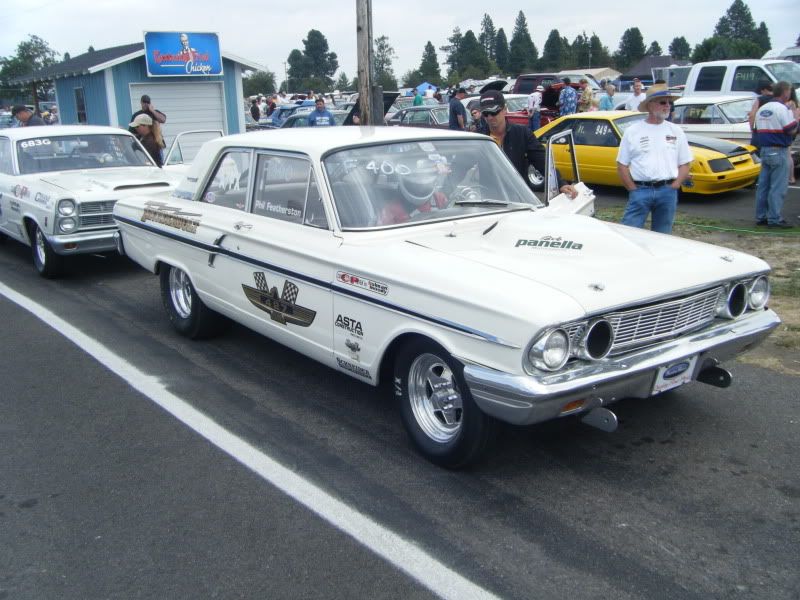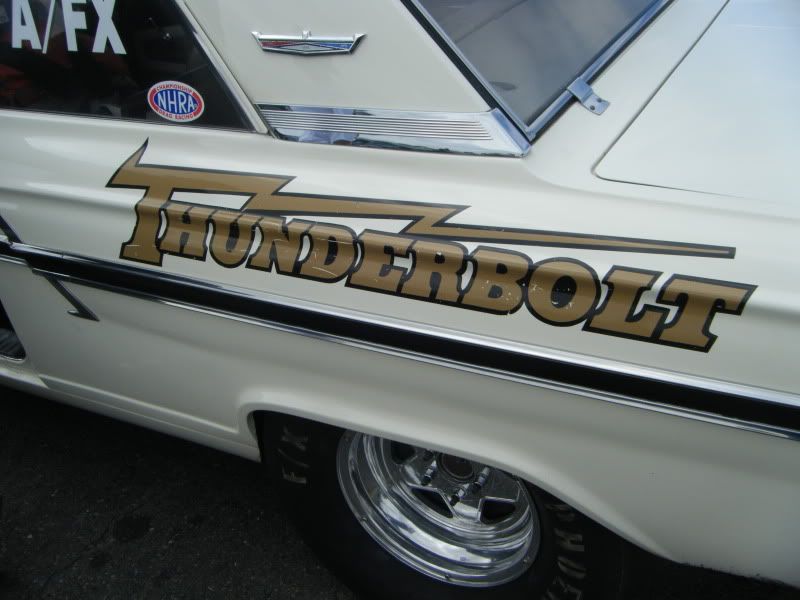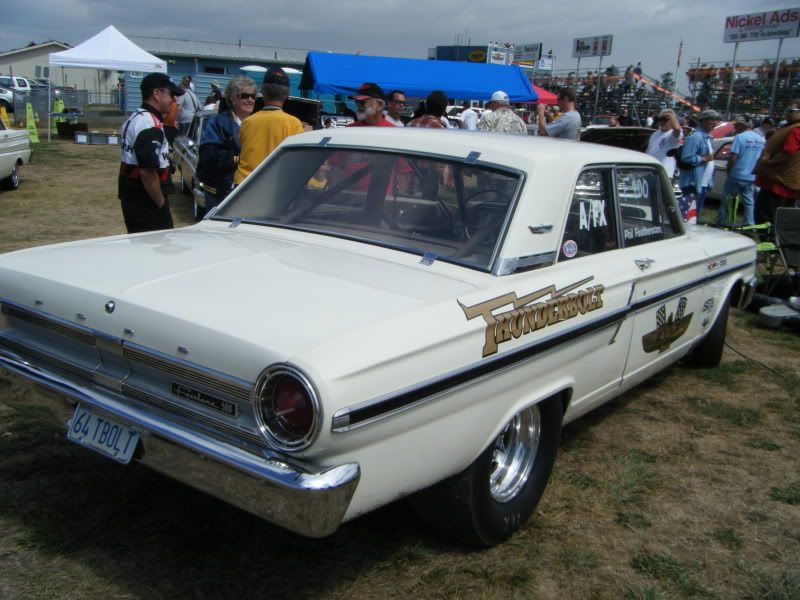the history of the T-bolt
n the winter of 1962, Jacque Passino realized Ford was in trouble. Jacque oversaw Ford's racing efforts, and even before the beginning of the '63 NHRA season in January, he recognized his new '63 1/2 Galaxie Super Stocks were too heavy to compete against the latest lightweight Plymouths, Dodges, Chevrolets, and Pontiacs. While each of these carmakers was using aluminum body panels and bumpers and stripping as much out of the interior as the rulebook would allow, Ford had chosen to use fiberglass hoods, fenders, and doors, along with aluminum bumpers and a lightweight frame. They had also saved a few pounds in the interior, but it wasn't enough. Ford had shaved roughly 700 pounds off the 4,150-pound Galaxie, but they were several hundred pounds heavier than the competition.
Jacque was confident that his brandnew 425hp 427-cid engine could outduel Chrysler's new 426 Wedge, Pontiac's 421, and Chevy's Z11 427. As the '63 season played out, the well-funded Ford teams were in the thick of competition, but they weren't consistent winners. When General Motors decided to pull out of racing in January 1963, Chevy and Pontiac closed the front and back factory doors to racers. Some covert parts made their way to favored drivers, but for the most part, if you raced a Chevy or a Pontiac, then you were on your own. That left Ford to battle Dodge and Plymouth, and it was no secret that these two Pentastar powerhouses were about to get a new powerplant in 1964-the 426 Hemi.
The Galaxie's first test was the NHRA Winternationals. Instead of racing in the Super Stock classes, Ford was yanked into Limited Production, as was Chevrolet. The NHRA's excuse was that not enough cars had been sold to qualify for Super Stock. The Super Stock class was all Mopar. The lightweight Galaxies fell to the Z11 Chevys early, and it was an all-Chevy show for the L/P finals. The only real bright spot for Ford in 1963 was **** Brannan capturing the NHRA S/S class record e.t. of 12.42 in his Galaxie.
Jacque had by now assembled a Special Vehicle program headed by Frank Zimmerman. Frank's first task was to assemble a "Ford Drag Council" of top drivers and supporting Ford dealers (like Tasca) located across the country. The program's first project was to reassess Ford's drag racing program and find alternatives to the heavy Galaxie. Super Stock racing had captured the public's imagination and was the fastest growing racing class in the NHRA. Dodge and Plymouth were aggressively supporting teams with lightweight cars and the new Hemi engine. To remain competitive, Ford had to race in Super Stock. Carmakers race to sell cars, but ego drives a manufacturer to spend money and build truly innovative and competitive cars.
One of Ford's most aggressive dealers in drag racing was Tasca Ford, a small agency in Cranston, Rhode Island. Robert Tasca recognized the value of "Race on Sunday, sell on Monday" and had successfully campaigned at local tracks. By 1962, his cars were going national. Tired of seeing Fords continue to be outgunned in the quarter-mile, Robert persuaded Ford to commission Detroit Steel Tubing (DST), a Detroit fabricator, to build an experimental lightweight '63 two-door Fairlane sedan with fiberglass front fenders, hood, rear decklid, and aluminum inner fender panels and bumpers. That dropped the weight down to 3,320 pounds. The Fairlane's engine compartment had to be highly modified to accept a 406-cid engine with dual four-barrels for A/FX competition. To legitimize the car in the NHRA's eyes, Ford issued a DSO (Domestic Special Order) number for the one-off Fairlane and a price of $3,300. It wasn't until the 427 was legalized in midyear that Robert's Fairlane (dubbed "Zimmy I" after Frank Zimmerman) became competitive, running 12.21/118.42 for the A/FX record.
Based on the success of Robert's Zimmy 1, Frank authorized the development of a lightweight 427-powered Fairlane for the '64 season. The program would consist of 100 cars, all powered by the 427, and all of them legal for Super Stock competition. Frank was determined not to allow the car, now named "Thunderbolt," to be jerked into any F/X classes. Although NHRA rules required a run of 50 cars, to ensure production legitimacy, Ford chose to build 100 instead. The first 50 were produced before December 31, 1963, to be eligible for the '64 race season. The second run was completed during the '64 model year.
DST was again selected to build the cars, based on Fairlane 500 twodoor sedans, modified from designs from Ford's Special Vehicles group. Since the NHRA's weight break had been refactored to 7.5 pounds per cubic inch, the Thunderbolt's total weight could not exceed 3,202 pounds with the 427. To achieve this, DST hung fiberglass front fenders, hood, doors, and bumpers (aluminum bumpers were later installed instead of fiberglass to satisfy complaints to the NHRA from Chrysler). Aside from the front and rear glass, all the windows were Plexiglas. In place of the front seat, a pair of lightweight Bostrom Econoline van bucket seats were installed. All insulation, dum-dum, and other sealers were deleted, and a rubber mat served as the floor covering. Heaters and radios were deleted.
To shoehorn the big 427 in the Fairlane, the inner fenders, upper control arms, and brackets were re-engineered. The inboard headlamp buckets were replaced with six-inchdiameter duct hoses that fed cold air to the dual carburetors via an aluminum airbox. The battery was moved to the trunk to clear the righthand duct hose, and a 125-pound truck battery was placed in the right rear to provide additional rear weight. NHRA had that changed to a 95-pound battery during the season, again to placate Chrysler.
The Thunderbolt's suspension was race-ready. The rear had beefed leaf springs (two leaves on the left and three on the right to counteract the 427's enormous torque at launch), and ladder bars built from square tubing were welded to link the axle to the frame. It was up to the customer to install a rollbar. Each Thunderbolt was fitted with NHRA S/S-spec seven-inch-wide cheater slicks.
The '64 Ford solid-lifter 427 high- riser engine was a thing of true mechanical beauty. All the lower-end oiling problems that plagued earlier FE-series engines had been solved. The block featured cross-bolted main caps to endure hard, high-rpm bursts, and the crank was forged steel. The 13.3:1 high-riser heads boasted tall 2.72x1.34- inch intake ports. The tall intake manifold placed the twin Holley 4150 carburetors above the ports, proving a direct shot to the valves. The lightweight alloy valves were tuliped for better flow. The intake valves were huge, measuring 2.19 inches, while the exhausts measured 1.73 inches, and the combustion chambers were fully machined. The exhaust ports were 1.86x1.30-inch, and custom tube headers snaked through the engine compartment and dumped behind the rear suspension. NHRA's S/S rules required a full exhaust, so an unconnected single pipe and muffler were installed for appearance only.
Ford advertised the 427's output at 425 hp at 6,000 rpm, with torque rated at 480 lb-ft at 3,700 rpm. Thunderbolts hitting the track were producing in excess of 525 hp with little tweaking. Thanks to the tall heads and airbox, a teardrop bubble hood was required to clear the engine.
Forty-one Thunderbolts received a BorgWarner T-10 four-speed with a special lightweight aluminum case. The other 59 got a beefed Lincoln Cruise- O-Matic three-speed automatic. Ford had been at a disadvantage to Dodge and Plymouth with their bulletproof TorqueFlite automatics and hoped the heavy-duty Lincoln boxes could compete in the SS/A class. The Cruise-Omatics lacked a high stall-speed torque converter, however, and many were eventually tossed in favor of the T-10. Both transmissions spun 4.56 gears in 9-inch rears.
In the Thunderbolt's first test under fire at the NHRA Winternationals at Pomona, Gas Rhonda clicked off a 12.05/120.16 to win the S/S class. As the season progressed, Thunderbolt drivers would whittle down e.t.'s and improve trap speeds as they learned how to set up and drive the lightweight Fairlanes. Ford finally had a competitor equal to the task of taking it to the S/S Dodges and Plymouths.
As the season wore on, it became apparent that in the S/S class, the T-bolts had an even chance against the Mopars. In the S/SA automatic class, the TorqueFlite proved it was still the superior transmission. Mopar drivers could run their engines up against the brakes for quick starts, and that gave them the winning advantage over the Cruise-O-Matic T-bolts. To cap off the season, Ford finished with an all- T-bolt final at the NHRA Nationals at Indy, pitting Gas Ronda against Butch "California Flash" Leal. Gas took the win with a 11.76 at 122.78.
For the '65 season, the NHRA changed the minimum production run to 500, making specialized cars like the Thunderbolt unfeasible to build. Ford canceled the Thunderbolt program, but not before they proved they could run against the mighty Hemi and win.
Of the 100 cars built, it's not known exactly how many exist today. After the first 50 T-bolts were distributed, just about anyone could walk into a Ford dealer and order a Thunderbolt. Number 68 is shown in the lead photo, and is owned by Bill and Susanne Turner of Fort Myers, Florida. Bill purchased the T-bolt in 2003 and is still researching its history. Amazingly, there's no evidence that Bill's T-bolt ever received a rollbar or a tubed cage, although it was briefly raced in the Northeast at tracks like Lebanon Valley in New York, where it was known as the "Hemi Hunter." From what Bill has learned, after a year of limited racing, the car was pulled off the track and rarely driven, which would explain the odometer reading of 8,100 miles. Along the way, the T-10 was replaced with a Ford Top Loader four-speed.


































